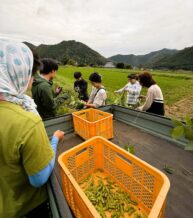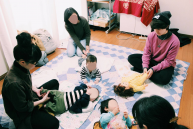My time at Kyōto’s Budō Center learning from Kawaguchi-sensei was a great privilege. From gradually finding a better sense of balance when taking off my shoes before practice (though never a sense of grace), performing the correct form over and over again without complaint (in the cold, without feeling in toes or fingers), to releasing my first arrow, I have gained a lot from my CIP experience. Many of the things I have learned have been through nonverbal experiences, but nevertheless I believe they certainly say much about the process of studying a Japanese cultural art form.
To shoot or not to shoot— this depends on what I would call the Kyudō Trifecta: Respect, Discipline, and Patience. My observations point to these three values as key in determining your success in studying kyudō.
Every practice began and ended with formal aisatsu, which consisted of waiting for and greeting sensei when she became free, and respectfully expressing our appreciation for her guidance in zarei (seated bow position). Only after completing aisatsu could we retrieve our equipment or take our leave. At the same time, there was not a strict, tense atmosphere like I imagined there would be. Rather, while taking practice seriously, the older students often joked with sensei, who also often displayed a dry sense of humor. I think it was because a high level of respect already existed between students and teacher, as shown through aisatsu at the beginning and end of practice, that this kind of warm atmosphere could be created. The importance of respect feeds into the other two pillars of the Kyudō Trifecta as well.
In practicing the same form endlessly, respecting the subtleties between each step, and keeping both the mind and body focused in silence takes, as you can imagine, great discipline. In my mind, this was an area of particular importance in which to succeed because I have always imagined it as (besides a general area of weakness in myself) an area of weakness in those not socialized into Japanese culture. Because sensei was often busy helping a number of students, practicing in silence while learning as much as possible from older students was vital. Without saying anything, experienced students would generously hop in front of us to practice and let us take careful note of their form. I really appreciated the sense of camaraderie created because students knew the difficulty and importance of preserving through moments of weak resolve. Luckily, patience, as the third pillar of the Kyudō Trifecta, made me more forgiving in the moments when my shoulders did slump and my eyes searched for a clock.
Patience also, I found, was key to finding the joy in chilly afternoon practices of repetition, repetition, repetition. In fact, the same level of patience required of us was vastly lower due to the nature of our short visit. Kawaguchi-sensei actually sped up the timeline in which we received a bow to hold, an arrow with which to practice the form, and the permission to actually release the string. Normal students would have been practicing the form for about two months before even holding a bow. And yet all the same, even in the short and far more ‘action-packed’ time I took kyudō lessons, I know that patience is what completes the Trifecta. From the tremendous range of students’ ages, I saw right from the start that kyudō is an art form you learn over a lifetime. In this way, I was able to relax in knowing that while striving for a kind of perfection, it was finding the joy and awe in the learning process that made my CIP experience so memorable.


 For my CIP, I joined Wasshoi, a circle at Kyoto University focused on agricultural activities, community engagement and rural revitalization in the small but beautiful village of Miyama. Together with a group of core members, I traveled to this village bimonthly to participate in activities such as edamame harvesting, building a corn maze for kids and harvesting thatch for a local renovation project!
For my CIP, I joined Wasshoi, a circle at Kyoto University focused on agricultural activities, community engagement and rural revitalization in the small but beautiful village of Miyama. Together with a group of core members, I traveled to this village bimonthly to participate in activities such as edamame harvesting, building a corn maze for kids and harvesting thatch for a local renovation project!
